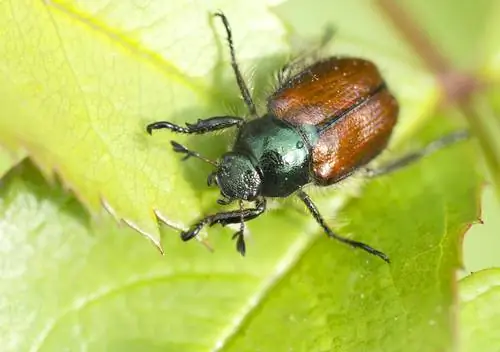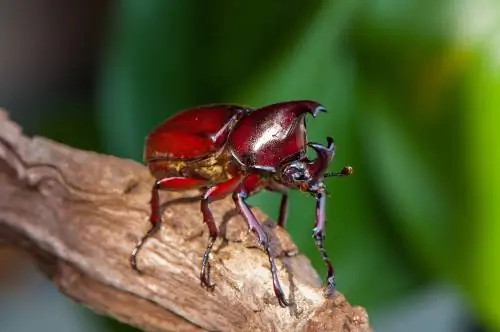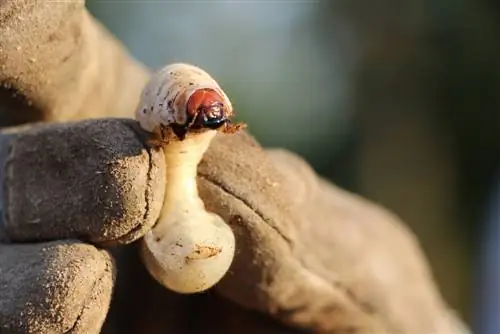- Author admin [email protected].
- Public 2023-12-16 16:46.
- Last modified 2025-06-01 06:02.
In May and June things get busy in the garden, park, field and forest. Brown beetles come out of the ground in droves, celebrate their wedding dance and feed on the plants. Two genera of beetles called May beetles and June beetles are responsible for the busy activity. A direct comparison reveals striking differences and reveals the secret of which beetle you are encountering.

What are the differences between May beetles and June beetles?
Cockchafers and June beetles differ in size, coloring, antenna shape and hair. May beetles are larger, have fan-shaped antennae and thinner hair, while June beetles are smaller, have tripartite antennae and thicker hair. May beetles are active in May, while June beetles are active in June and July.
- Cockchafers and June beetles differ in size, coloring, antenna shape and hair.
- In a direct comparison, a cockchafer is larger, has different colors, has fan-shaped antennae and thinner hair.
- The scientifically correct name of the June beetle is ribbed curlew beetle (Amphimallon solstitiale).
May beetle vs June beetle - comparison
It is hardly surprising that nature lovers and amateur gardeners often lump cockchafers and June beetles together. At first glance, both beetles look very similar, because cockchafers and June beetles belong to the family of scarab beetles (Scarabaeidae). Only upon closer inspection do striking differences become apparent that make a direct comparison useful. The following table is full of tips on how to tell cockchafers and June beetles apart:
| Differences | Cockchafer | June beetle |
|---|---|---|
| botanical name | Melolontha melolontha, M. hippocastani | Amphimallon solstitiale |
| Common name | Field cockchafer, forest cockchafer | Ribbed Curlew Beetle |
| Size | 2, 2-3, 5 cm | 1, 4-1, 8 cm |
| color | red brown, dark brown, black | leather yellow to light brown |
| Drawing | white spots on the back side | none |
| Hair | fitting, white, spotted | bristy, opaque, brown |
| Sensor | fan-shaped, distinctive | three-part, inconspicuous |
| Prime flight time | May | June and July |
| Activity | diurnal | twilight and nocturnal |
Regardless of the common family name scarab beetle, there are clear differences between the May beetle and the June beetle. These deviations are examined in more detail below:
Appearance

Cockchafers are reddish-brown above and black on the underbelly
Characteristic of the cockchafer is the different coloring of the individual body parts. The wing coverts are reddish brown to dark brown. The head, pronotum and underside of the body are black. What is striking is a striking marking on the flanks of the abdomen in the form of white, triangular spots that are reminiscent of a zigzag pattern. A patchy patch of light hair is just visible on the cockchafer or can be felt with your finger.
The June beetle has a uniform, light brown body color. He also does without the striking decoration with zigzag lines on the sides. However, a June beetle cannot completely resist some decorative ornaments. Three raised ribs on each wing are its trademark, from which the ribbed curlew beetle gets its name. Another outstanding difference to the cockchafer is the pronounced hairiness that covers the entire beetle.
Are there still any doubts about the comparison of cockchafers vs June beetles? Then take a look at the feelers. The cockchafer proudly carries its awe-inspiring antennae with fan-shaped clubs that boast six to seven lamellae. The number of slats reveals the beetle's gender. Six lamellae on the fan feeler identify a female. If you count seven lamellae on the antennae, it is a male. In contrast, the three-parted, small antennae of the ribbed curlew beetle appear very modest.
Main flight time and activity
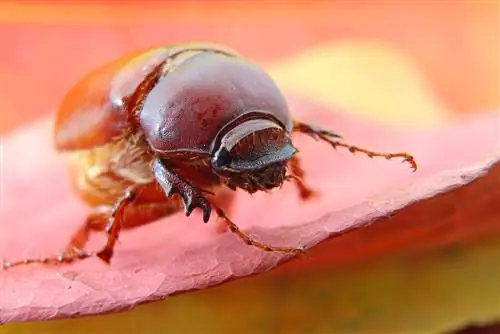
June beetles only fly out to look for a bride in June
June beetles take things slower than May beetles. When adult curlew beetles soar through the air on their nuptial flight in June and July, cockchafers have long since completed their family planning. For field cockchafers and forest cockchafers, the main flight season is from the end of April to the end of May. Every now and then in June there are still a few stragglers among the May beetles, which are mistakenly called June beetles.
Furthermore, June beetles like to oversleep and waste away the day and only fly off at dusk. In contrast, May beetles are enthusiastic early risers and complete most of their beetle duties in daylight.
Larvae in a uniform look
With regard to the cycle and appearance of their larvae, there is no significant difference between the May beetle and the June beetle. Fertilized females lay their eggs in the ground, in close proximity to all kinds of plants. Immediately after hatching, the caterpillars begin to feed by eating the roots. The appearance is characterized by the typical grub shape, which gives no indication of the later beetle species. Each grub completes a cycle of 3 to 5 years, has a cylindrical body with a brown head and adopts a hunched posture. Only when the finished beetles come out of the ground after two to three overwinterings and pupation does it become apparent whether they are a May beetle or a June beetle.
Excursus
Ladybug - symbol of luck and beneficial insect

Ladybirds don't have much in common with cockchafers
Don't confuse cockchafers (Melolontha) with ladybirds (Coccinellidae). What both beetles have in common is limited to the similar naming in everyday language. Listing all the differences between cockchafers and ladybirds would go beyond the scope of this guide. In fact, ladybugs form a separate family of insects with 6,000 species worldwide. Popular in Europe as a beneficial insect and revered as a symbol of good luck is the colorful seven-spot ladybird with bright red cover wings. Nature-oriented hobby gardeners warmly welcome ladybugs because their larvae eat huge amounts of aphids. An informative article on Wikipedia provides a detailed insight into the wonderful world of ladybugs.
Differences to rose beetles
May beetles and rose beetles are distantly related to each other as members of the scarab beetle family. In a direct comparison of adult beetles, the first glance provides certainty about their identity. With their shimmering splendor, rose beetles are a feast for the eyes. European species have picturesque names such as the golden rose beetle (Cetonia aurata) or the bronze-green rose beetle (Protaetia lugubris). Take a look at Wikipedia's diverse, informative articles with lots of pictures of breathtakingly beautiful rose beetles.
In contrast to the brilliant rose beetle, the brown cockchafer is not just a Cinderella. Rose beetles feed primarily on nectar, pollen and tree sap. Every now and then the noble beetle beauties nibble on the flowers of roses, which does not cause any significant damage. Sometimes minimal traces of tiny beetle teeth can be discovered on the flowers of cherry, plum, elderberry and hawthorn. Cockchafers, on the other hand, target the foliage of trees and bushes, which can lead to leaf damage in local masses.
Rose beetles are under protection
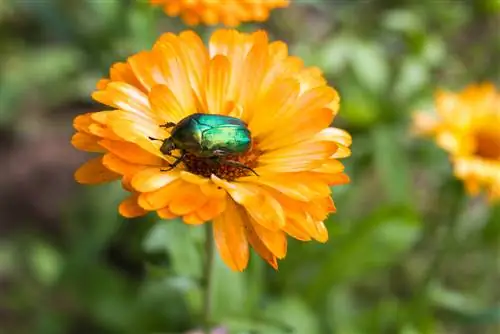
Rose beetles do not look similar to May and June beetles
As already explained in the comparison of May beetles and June beetles, larvae of scarab beetles cannot be distinguished. This circumstance has tragic effects on the harmless rose beetle. Although its grubs feed exclusively on sludge and decomposing organic matter, they are often confused with cockchafer larvae and are destroyed. As a result, some of the most beautiful rose beetle species have come into distress. For this reason, the Federal Nature Conservation Act lists the golden rose beetle, for example, as a protected species so that it does not end up on the Red List of seriously threatened species.
Tip
Cockchafer plagues with the widespread destruction of forests and crops are a thing of the past. In the worst case scenario, a high number of May beetles can occur locally if the larvae nest under the lawn or in the vegetable patch. Nematodes of the genus Heterorhabditis have proven to be effective in combating the disease without using poison. The nematodes parasitize and destroy any voracious grub within 2 to 3 days.
Frequently asked questions
What is the difference between cockchafer and ladybug?
Both beetles are not closely related. Rather, they are two completely different families of insects. Both beetles can be clearly distinguished visually. Cockchafers have inconspicuous brown wings. Ladybugs prefer a colorful appearance with red, yellow, brown or shiny black wings, which are often decorated with black, yellow or red dots. In addition, a cockchafer with a body length of 25 to 30 mm is a giant compared to the ladybird. The popular seven-spot ladybird, for example, has a body length of just 5 to 8 mm.
Do cockchafers only fly in May?
No. Cockchafers are popularly called this because their main flight season is in May. After a mild winter, the beetles often leave their winter quarters in April and go in search of food and a suitable partner. Flying cockchafers can be observed until June and like to attack the leaves of trees. These late bloomers are sometimes referred to as June beetles, although the ribbed curlew beetle actually has this name.
Are cockchafers and June beetles related?
Yes, because both beetles belonged to the scarab beetle family of insects (Scarabaeidae). This circumstance is reflected in a similar appearance, which at first glance poses a risk of confusion. Of course, there are striking differences between the May beetle and the June beetle, which led scientists to divide both beetles into two different genera. The June beetle is the so-called ribbed curlew beetle (Amphimallon solstitiale), which occurs between June and July. In contrast to the May beetle (Melolontha), a June beetle is smaller, has three-part antennae and is very hairy.
Are rose beetles harmful to roses?
With their dazzling appearance and an impressive size of 1.5 to 3 centimeters, rose beetles cannot be overlooked. If the magnificent beetles are on your roses, there is no reason to worry. The lovable hummers are primarily after sweet nectar and nutritious pollen. Every now and then a rose petal gets between the teeth, which does not have any serious consequences for the plant.
Tip
The compost heap becomes a treasure trove when you discover a fat grub in it. It is usually a rose beetle larva. With a little luck, you will hold a rhinoceros beetle grub in your hands, another priceless, rare jewel of nature. Please put the larvae back into the compost so that they can complete their cycle and delight us as dazzling beetle beauties or impressive beetle giants.



